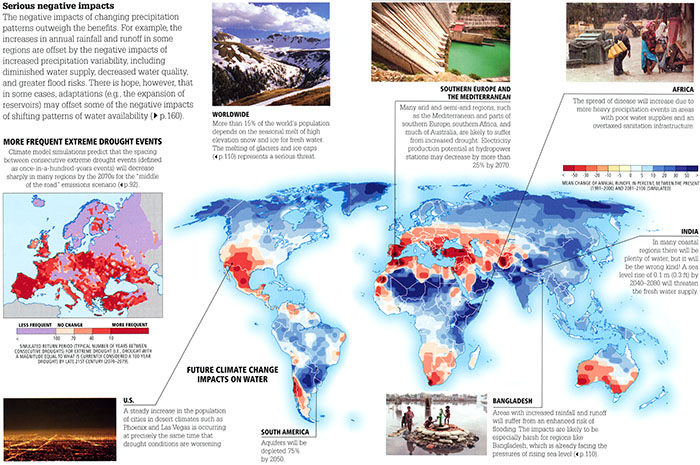We saw in our previous lesson on climate change impacts, that anthropogenic climate change could profoundly influence freshwater availability around the world.

- Serious Negative Impacts: The negative impacts of changing precipitation patterns outweigh the benefits. For example, the increases in annual rainfall and runoff in some regions are offset by the negative impacts of increased precipitation variability, including diminished water supply, decreased water quality, and greater flood risks. There is hope, however, that in some cases, adaptations (e.g. the expansion of reservoirs) may offset some of the negative impacts of shifting patterns of water availability.
- More Frequent Extreme Drought Events: Climate model simulations predict that the spacing between consecutive extreme drought events (defined as once-in-a-hundred-years events) will decrease sharply in many regions by the 2070s for the "middle of the road" emissions scenario.
- Future Climate Change Impacts on Water
- U.S. - A steady increase in the population of cities in desert climates such as Phoenix and Las Vegas is occurring at precisely the same time that drought conditions are worsening
- South America - Aquifers will be depleted 75% by 2050.
- Southern Europe and the Mediterranean - Many arid and semi-arid regions, such as the Mediterranean and parts of Southern Europe, Southern Africa, and much of Australia, are likely to suffer from increased drought. Electricity production potential to hydropower stations may decrease by more than 25% by 2070.
- Africa - The spread of disease will increase due to more heavy precipitation events in areas with poor water supplies and an overtaxed sanitation infrastructure.
- India - In many coastal regions there will be plenty of water, but it will be the wrong kind! A sea level rise of 0.1 m (0.3 ft) by 2040-2080 will threaten the fresh water supply.
- Bangladesh - Areas with increased rainfall and runoff will suffer from an enhanced risk of flooding. The impacts are likely to be especially harsh for regions like Bangladesh, which is already facing the pressures of rising sea level.
- Worldwide - More than 15% of the world's population depends on the seasonal melt of high elevation snow and ice for fresh water. The melting of glaciers and ice caps represent a serious threat.
© 2015 Pearson Education, Inc.
What, if any, measures could we take to adapt to these changes? Possible adaptations can, in fact, be found on both the supply side and the demand side.
Let us first consider some supply-side options. Freshwater could, for example, be transported from regions that are likely to see more precipitation to those likely to see less. The required transport (which costs both money and energy!) could be minimized by exploiting the fact that in many cases such regions are reasonably near to each other, e.g., tropical Africa (more runoff) vs. South Africa (less runoff), or the Pacific Northwest (more runoff) vs. desert southwest (less runoff) of U.S., or Northern Europe (more runoff) vs. Southern Europe and Mediterranean (less runoff). Other possibilities involve greater exploitation of groundwater sources, though this faces the challenge of over-tapped aquifers, which is already a problem in the U.S. Desalinization makes sense, particularly for coastal regions of the U.S., Australia, and the Mediterranean which are predicted to dry, and where a nearby saltwater source would help minimize transportation costs. Desalinization is currently highly expensive and extremely energy intensive, making it a prohibitive source of freshwater today. However, as water resources diminish and technology improves, it is possible that desalinization will become a more viable option in the future. See table below for other possible supply-side solutions.
What about the demand side? More efficient recycling of water and better conservation of water resources is an obvious approach. Both constitute what is often referred to as no regrets approaches — a concept we will encounter later in the context of climate change mitigation. Such actions not only cost us nothing, but they could, in fact, provide benefits, e.g., lower household water bills! Similarly, more efficient means of irrigation of crops could save water and provide other benefits as well.
Another possibility is the idea of tradable water access rights. This too has an analogy with climate change mitigation, since one approach that has been suggested for reducing carbon emissions is to allow individual companies limited numbers of permits for emitting and then letting them trade and sell them. The same thing could be done for rights to water resources. The idea behind this is that the efficiencies of the free market will, at least in principle, find the most cost-effective means of meeting water resource needs, since those with excess fresh water would be motivated to sell their valuable water rights to others willing to pay a premium for them.
| Supply Side | Demand Side |
|---|---|
| Prospecting and extraction of water | Improvement of water-use efficiency by recycling groundwater |
| Increase of storage capacity by building reservoirs and dams | Reduction in water demand for irrigation by changing the cropping calendar, crop mix, irrigation method, and area planted |
| Desalination of seawater (via reverse osmosis systems) | Reduction in water demand for irrigation by importing products |
| Expansion of rainwater storage | Adoption of indigenous practices for sustainable water use (drawing upon local cultural knowledge in establishing efficient practices) |
| Removal of invasive, non-native vegetation from river margins | Expanded use of water markets to reallocate water to highly valued areas |
| Transport of water to regions where needed | Expanded use of economic incentives, including metering, and pricing to encourage water conservation |
© 2015 Pearson Education, Inc.
